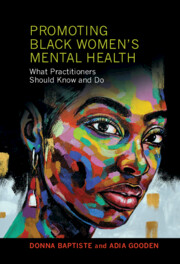Book contents
- Promoting Black Women’s Mental Health
- Promoting Black Women’s Mental Health
- Copyright page
- Contents
- Figures
- Tables
- Contributors
- Introduction
- Part I Black Women in Context
- 1 A Study of Black Women and Psychotherapy
- 2 Social Determinants of Health and Mental Health for Black Women
- 3 Black Girlhood: Developmental Experiences of Black Women
- 4 Stereotypes of Black Women: Clinical Implications
- 5 Black Women and Trauma
- Part II Therapy Contexts
- Part III Core Themes in Black Women’s Stress and Distress
- Part IV Helping Black Women Recover and Thrive
- Appendix
- Index
- References
3 - Black Girlhood: Developmental Experiences of Black Women
from Part I - Black Women in Context
Published online by Cambridge University Press: 22 June 2023
- Promoting Black Women’s Mental Health
- Promoting Black Women’s Mental Health
- Copyright page
- Contents
- Figures
- Tables
- Contributors
- Introduction
- Part I Black Women in Context
- 1 A Study of Black Women and Psychotherapy
- 2 Social Determinants of Health and Mental Health for Black Women
- 3 Black Girlhood: Developmental Experiences of Black Women
- 4 Stereotypes of Black Women: Clinical Implications
- 5 Black Women and Trauma
- Part II Therapy Contexts
- Part III Core Themes in Black Women’s Stress and Distress
- Part IV Helping Black Women Recover and Thrive
- Appendix
- Index
- References
Summary
This chapter examines themes in Black women’s childhood experiences. We discuss the importance of sex and gender identity development and other dynamics that affect Black girls’ self-concepts. We explore themes that surface when Black women’s girlhood experiences are the primary reasons for seeking therapy. Themes include the impact of the media on Black girls’ body image, the “adultification” of Black girls, sexual development, teenage parenting, and more. We emphasize how therapists can work with Black women around their painful childhood and adolescent memories.
Keywords
- Type
- Chapter
- Information
- Promoting Black Women's Mental HealthWhat Practitioners Should Know and Do, pp. 65 - 87Publisher: Cambridge University PressPrint publication year: 2023



